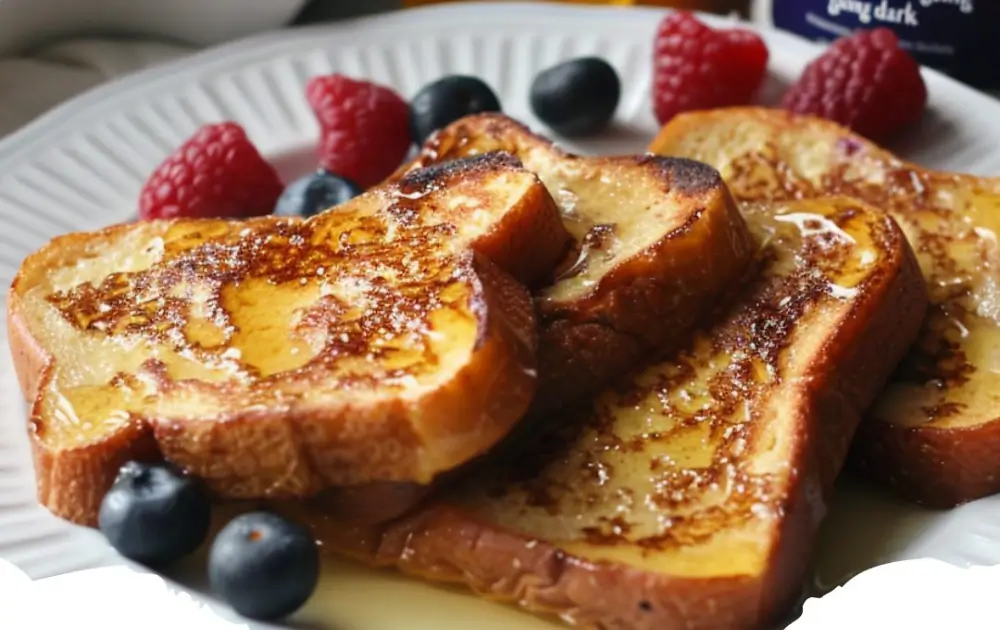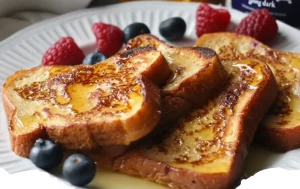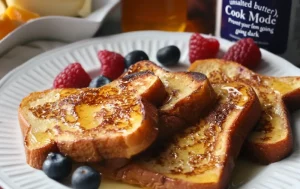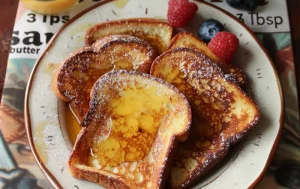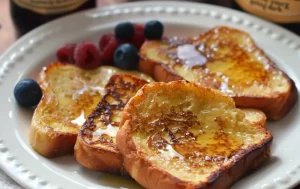French Toast is a beloved breakfast dish known for its sweet, custardy interior and golden-brown exterior. This classic dish transforms day-old bread into a decadent meal, combining simple ingredients like eggs, milk, and bread with the rich flavors of vanilla and cinnamon. It’s a versatile recipe that can be dressed up with fruit, syrup, and powdered sugar or made savory with herbs and cheese.
Selecting the Right Bread
The key to perfect French Toast lies in the choice of bread. Thick, sturdy slices like brioche, challah, or French bread work best, as they soak up the egg mixture without falling apart. Day-old bread is preferable because its drier texture absorbs more flavor, resulting in a richer taste.
Print
French Toast
- Author: recipstep
- Total Time: 30 minutes
- Yield: Serves 4
- Diet: Vegetarian
Description
French Toast is a timeless breakfast dish where slices of bread are dipped in a rich custard mixture, then fried until golden brown. It’s versatile, allowing for both sweet and savory variations, and can be topped with everything from syrup and fruit to cheese and herbs.
Ingredients
6 large eggs
2 large egg yolks
1 cup whole milk
1/4 tsp salt
2 tsp vanilla extract
1 tsp ground cinnamon
1 Tbsp warm honey
1 lb bread such as Challah, Brioche, or Texas Toast, (about 8-10, 3/4”-thick slices)
3 Tbsp unsalted butter, to saute toasts
Prevent your screen from going dark
Instructions
Slice your bread about 3/4″ thick, and arrange on a wire rack for 1-2 hours if time permits to dry out the bread slightly. Preheat the oven to 275˚F.
In a medium bowl, whisk together eggs, yolks, milk, salt, vanilla, cinnamon, and warm honey until well blended and honey has dissolved. Pour into a casserole dish that fits 4 pieces of toast at a time, or as many as will fit your skillet at a time.
Preheat your skillet over medium-low heat and melt in 2 Tbsp butter.
Dip 4 pieces of bread into the egg mixture at a time and soak for 30-40 seconds per side depending on the thickness of the bread. Remove bread slices from egg wash letting excess drip back into the dish then place the bread slices into the hot skillet and saute for 3-4 minutes per side until golden brown.
Transfer to a baking sheet and place in the oven to keep warm at 275˚F. Repeat step 4 with the remaining toast, adding more butter as needed. Once all are sauteed, keep them in the oven for another 10-15 minutes for the custard center to fully set then serve warm with your favorite toppings.
Notes
- Day-old bread works best as it absorbs more of the egg mixture without falling apart.
- For a non-dairy version, substitute milk with almond or coconut milk.
- Add a tablespoon of sugar to the custard mixture for sweeter French Toast.
- Can be adapted for vegetarian and non-dairy preferences.
- Prep Time: 10 minutes
- Cook Time: 20 minutes
- Category: Breakfast/Brunch
- Method: Pan-frying
- Cuisine: French
Nutrition
- Calories: Approximately 300 per serving (without toppings)
- Sugar: 5g (varies with toppings)
- Sodium: 400mg
- Fat: 15g
- Carbohydrates: 30g
- Protein: 12g
FAQs About French Toast
Can I make French Toast without eggs? Yes, you can make eggless French Toast by using a mixture of milk (dairy or non-dairy), flour, and mashed banana or applesauce as a binding agent. This mixture can mimic the custard-like consistency of traditional egg-based recipes.
What’s the best way to keep French Toast warm for a crowd? To keep French Toast warm for a crowd, preheat your oven to 200°F and place cooked slices on a baking sheet in the oven until ready to serve. This method keeps the French Toast warm without drying it out.
How can I prevent my French Toast from becoming soggy? To prevent French Toast from becoming soggy, use day-old bread that’s slightly dry, as it absorbs the egg mixture better without falling apart. Also, ensure your pan is hot enough before adding the bread to get a quick sear on the outside.
Is there a quick method for making French Toast? For a quicker version of French Toast, use thinner slices of bread and a slightly higher cooking temperature. This reduces soaking and cooking time, making it possible to prepare the dish in just a few minutes.
Can French Toast be made ahead and frozen? Yes, French Toast can be made ahead and frozen. Cook the French Toast as usual, allow it to cool, then freeze the slices on a baking sheet. Once frozen, transfer them to a freezer-safe bag. Reheat in the oven or toaster for a quick breakfast option.
Preparing the Egg Mixture
To create the custard base, whisk together eggs, milk, a dash of vanilla extract, and a sprinkle of cinnamon. For a richer flavor, some opt to use half-and-half or cream instead of milk. The addition of a pinch of salt enhances the sweetness of the dish, creating a well-rounded flavor profile.
Soaking the Bread
Dip each slice of bread into the egg mixture, ensuring both sides are well-coated but not soggy. The bread should absorb the liquid evenly, allowing the flavors to permeate throughout. Letting the bread sit for a few seconds on each side typically achieves the perfect saturation level.
Cooking to Perfection
Heat a skillet or griddle over medium heat and melt a pat of butter to prevent sticking. Place the soaked bread slices on the skillet, cooking until the bottom is golden brown and crispy. Flip carefully to cook the other side, adjusting the heat as needed to avoid burning. The ideal French Toast is crispy on the outside while still soft and custardy inside.
Serving Suggestions
Serve French Toast immediately while it’s still warm and crispy. Top with powdered sugar, maple syrup, fresh berries, or whipped cream for a sweet finish. For a savory version, consider adding grated cheese, cooked bacon, or a sprinkle of fresh herbs before the final flip in the skillet. French Toast offers a canvas for creativity, allowing for endless variations based on personal preference and seasonal ingredients.
Experimenting with Flavors and Toppings
To elevate your French Toast, don’t hesitate to experiment with different flavors and toppings. Mix in orange zest or almond extract into the egg mixture for a citrusy or nutty twist. Toppings like caramelized bananas, sautéed apples, or a berry compote add a delightful sweetness and texture contrast. For those who prefer a less traditional approach, savory toppings like avocado and smoked salmon can transform French Toast into a gourmet brunch item.
Making Ahead and Storage Tips
French Toast can be a convenient make-ahead dish for busy mornings or large gatherings. Prepare the soaked bread slices and lay them on a baking sheet to freeze individually. Once frozen, transfer them to a ziplock bag for easy storage. When ready to eat, cook them directly from frozen, adding a few extra minutes to the cooking time. Leftover cooked French Toast can be refrigerated and quickly reheated in a toaster or oven for a crisp texture.
Nutritional Considerations
For a healthier version of French Toast, consider using whole grain bread, almond milk, and egg whites. Sweeten naturally with mashed bananas or pureed dates in the egg mixture, and top with fresh fruit instead of syrup. These substitutions can help lower the dish’s sugar and calorie content while adding fiber and nutrients.
The Cultural Significance of French Toast
French Toast, known as “pain perdu” in France, has a long history and is enjoyed in various forms around the world. Understanding its origins and the global variations can add an appreciation for this humble dish. From the savory “eggy bread” in the UK to the sweet Hong Kong-style French Toast filled with peanut butter, exploring these versions can be a culinary adventure.
Hosting a French Toast Brunch
Hosting a French Toast-themed brunch is a fantastic way to gather friends and family for a delicious meal. Offer a variety of toppings and sides like bacon, sausages, and scrambled eggs, allowing guests to customize their plates. A French Toast bar with different breads, egg mixtures, and toppings can cater to various tastes and dietary preferences, making it an inclusive and interactive dining experience.
Pairing with the Perfect Beverages
To complement the richness of French Toast, consider pairing it with beverages that enhance its flavors. A hot cup of coffee or a cappuccino cuts through the sweetness with its bitter notes, while fresh orange juice provides a tangy contrast. For a more indulgent brunch, a glass of sparkling wine or a mimosa adds a festive touch, making the meal feel like a special occasion.
Utilizing Seasonal Ingredients
Incorporating seasonal ingredients into your French Toast can bring fresh flavors and colors to the dish. In the summer, top with ripe peaches, strawberries, or blueberries. During fall and winter, add spiced apples, pears, or pumpkin puree to the egg mixture for a comforting seasonal twist. This not only elevates the taste but also connects the meal to the time of year, making it more memorable.
Mastering the Cooking Technique
Achieving the perfect texture for French Toast requires attention to detail in the cooking process. Ensure the skillet is at the right temperature before adding the bread—a preheated pan helps in achieving a crispy exterior without burning. Cook each piece until it’s just firm, avoiding overcooking, which can dry out the custard interior. Mastering this technique ensures every bite is satisfyingly crisp on the outside and soft and creamy on the inside.
Engaging Guests with Interactive Cooking
Turn the preparation of French Toast into an interactive experience by inviting guests to participate in the cooking process. Set up a station where they can dip their bread into their chosen egg mixture and select their toppings. This not only makes the meal more engaging but also allows guests to customize their French Toast to their liking, ensuring everyone has a dish they enjoy.
Exploring International Variations
This recipe is a versatile dish enjoyed in many cultures around the world with unique twists. Exploring these international variations can inspire new ideas and flavors for your recipe creations. From the sweet, syrupy versions in North America to the savory, spicy takes found in Asia, each culture brings its own interpretation to the table. Experimenting with these global flavors and techniques can broaden your culinary horizons and introduce you to new ways of enjoying this classic dish.
Innovating with Unique Bread Choices
Venturing beyond traditional white bread can transform your recipe into an extraordinary dish. Artisanal breads such as sourdough, ciabatta, or a dense fruit loaf add unique flavors and textures. Each type of bread brings something different to the table, from the tangy depth of sourdough to the sweet, dense bites of fruit loaf. Experimenting with these options can elevate your recipe from a simple breakfast to a gourmet experience.
Focusing on Presentation
The presentation of the recipe can significantly enhance its appeal. Arrange your recipe on a plate with intention, layering slices and artfully drizzling them with syrup or sauce. A sprinkle of powdered sugar, a few fresh mint leaves, or a side of beautifully sliced fruit can turn the dish into a visual masterpiece, making it as delightful to look at as it is to eat.
Creating a Sweet and Savory Balance
For those who love a combination of sweet and savory flavors, it offers the perfect canvas. Adding a slice of ham between two slices of French Toast or topping it with crispy bacon and a drizzle of maple syrup brings together the best of both worlds. This contrast of flavors can satisfy a wider range of taste preferences and make for a more intriguing dish.
Utilizing Leftovers Creatively
This recipe isn’t just a breakfast dish; it can also be a creative way to use leftovers. Day-old French Toast can be repurposed into a delicious bread pudding, layered with fruit and baked with an extra custard mixture. Alternatively, cut it into strips and bake until crispy for a sweet twist on traditional breadsticks. These innovative uses ensure that nothing goes to waste and that every meal is an opportunity for creativity.
Sharing Recipes and Experiences
The joy of cooking is amplified when shared with others. Sharing your recipe, along with tips and personal twists, can inspire others to explore their culinary skills. Whether through social media, blogs, or cooking classes, spreading the love for cooking brings people together, fostering a community of food enthusiasts who appreciate the art of making and enjoying good food. Sharing not only enriches others’ culinary lives but also encourages a culture of creativity and experimentation in the kitchen.
Conclusion
This recipe stands as a testament to the beauty of transforming simple ingredients into a delicious, comforting meal. Whether you prefer it sweet or savory, this versatile dish can be tailored to suit any palate, making it a beloved choice for breakfast and brunch worldwide. By experimenting with bread types, flavors, and toppings, you can elevate French Toast from a basic breakfast staple to a gourmet delight. Remember, the key to great French Toast lies in the quality of ingredients, the right technique, and a dash of creativity. So, gather your ingredients, heat up your griddle, and get ready to enjoy a slice of culinary bliss that’s sure to start your day on a high note.

